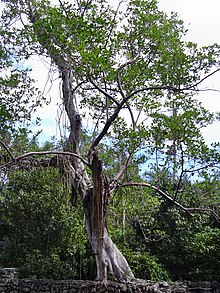
Back تين ذهبي Arabic تين ذهبى ARZ Ficus aurea AST Ficus aurea Azerbaijani Ficus aurea CEB Ficus aurea Spanish Pikondo itotzaile Basque Ficus aurea French Ficus aurea ID Ficus aurea Italian
| Florida strangler fig | |
|---|---|

| |
| Florida strangler fig in Deering Park, Florida | |
| Scientific classification | |
| Kingdom: | Plantae |
| Clade: | Tracheophytes |
| Clade: | Angiosperms |
| Clade: | Eudicots |
| Clade: | Rosids |
| Order: | Rosales |
| Family: | Moraceae |
| Genus: | Ficus |
| Subgenus: | F. subg. Urostigma |
| Species: | F. aurea
|
| Binomial name | |
| Ficus aurea Nutt. 1846, conserved name
| |
| Synonyms[3] | |
|
Synonymy
| |
Ficus aurea, commonly known as the Florida strangler fig (or simply strangler fig), golden fig, or higuerón,[4] is a tree in the family Moraceae that is native to the U.S. state of Florida, the northern and western Caribbean, southern Mexico and Central America south to Panama.[5] The specific epithet aurea was applied by English botanist Thomas Nuttall who described the species in 1846.
Ficus aurea is a strangler fig. In figs of this group, seed germination usually takes place in the canopy of a host tree with the seedling living as an epiphyte until its roots establish contact with the ground. After that, it enlarges and strangles its host, eventually becoming a free-standing tree in its own right. Individuals may reach 30 m (100 ft) in height. Like all figs, it has an obligate mutualism with fig wasps: figs are only pollinated by fig wasps, and fig wasps can only reproduce in fig flowers. The tree provides habitat, food and shelter for a host of tropical lifeforms including epiphytes in cloud forests and birds, mammals, reptiles and invertebrates. F. aurea is used in traditional medicine, for live fencing, as an ornamental and as a bonsai.
- ^ IUCN SSC Global Tree Specialist Group & Botanic Gardens Conservation International (BGCI) (2020). "Ficus aurea". IUCN Red List of Threatened Species. 2020: e.T181217702A181464731. doi:10.2305/IUCN.UK.2020-3.RLTS.T181217702A181464731.en. Retrieved 2 October 2022.
- ^ Cite error: The named reference
Brummitt2005was invoked but never defined (see the help page). - ^ "The Plant List".
- ^ Cite error: The named reference
Harvey1998was invoked but never defined (see the help page). - ^ Berg, C.C. (2007). "Proposals for treating four species complexes in Ficus subgenus Urostigma section Americanae (Moraceae)". Blumea. 52 (2): 295–312. doi:10.3767/000651907X609034.
